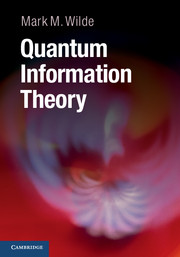Book contents
- Frontmatter
- Contents
- How To Use This Book
- Acknowledgments
- Part I Introduction
- Part II The Quantum Theory
- Part III Unit Quantum Protocols
- Part IV Tools of Quantum Shannon Theory
- Part V Noiseless Quantum Shannon Theory
- 17 Schumacher Compression
- 18 Entanglement Concentration
- Part VI Noisy Quantum Shannon Theory
- Appendix A Miscellaneous Mathematics
- Appendix B Monotonicity of Quantum Relative Entropy
- References
- Index
18 - Entanglement Concentration
from Part V - Noiseless Quantum Shannon Theory
Published online by Cambridge University Press: 05 May 2013
- Frontmatter
- Contents
- How To Use This Book
- Acknowledgments
- Part I Introduction
- Part II The Quantum Theory
- Part III Unit Quantum Protocols
- Part IV Tools of Quantum Shannon Theory
- Part V Noiseless Quantum Shannon Theory
- 17 Schumacher Compression
- 18 Entanglement Concentration
- Part VI Noisy Quantum Shannon Theory
- Appendix A Miscellaneous Mathematics
- Appendix B Monotonicity of Quantum Relative Entropy
- References
- Index
Summary
Entanglement is one of the most useful resources in quantum information processing. If a sender and receiver share noiseless entanglement in the form of maximally entangled states, then Chapter 6 showed how they can teleport quantum bits between each other with the help of classical communication, or they can double the capacity of a noiseless qubit channel for transmitting classical information. We will see further applications in Chapter 20 where they can exploit noiseless entanglement to assist in the transmission of classical or quantum data over a noisy quantum channel.
Given the utility of maximal entanglement, a reasonable question is to ask what a sender and receiver can accomplish if they share pure entangled states that are not maximally entangled. In the quantum Shannon-theoretic setting, we make the further assumption that the sender and receiver can share many copies of these pure entangled states. We find out in this chapter that they can “concentrate” these non-maximally entangled states to maximally entangled ebits, and the optimal rate at which they can do so in the asymptotic limit is equal to the “entropy of entanglement” (the von Neumann entropy of half of one copy of the original state). Entanglement concentration is thus another fundamental task in noiseless quantum Shannon theory, and it gives a different operational interpretation to the von Neumann entropy.
Entanglement concentration is perhaps complementary to Schumacher compression in the sense that it gives a firm quantum information-theoretic interpretation of the term “ebit” (just as Schumacher compression did for the term “qubit”), and it plays a part in demonstrating how the entropy of entanglement is the unique measure of entanglement for pure bipartite states.
- Type
- Chapter
- Information
- Quantum Information Theory , pp. 429 - 446Publisher: Cambridge University PressPrint publication year: 2013



